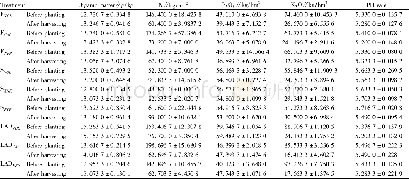《Table 1 Crop sequences and stubbles in the field under two phases from 2001 to 2013》
 提示:宽带有限、当前游客访问压缩模式
提示:宽带有限、当前游客访问压缩模式
本系列图表出处文件名:随高清版一同展现
《Suppression of weeds and weed seeds in the soil by stubbles and no-tillage in an arid maize-winter wheat-common vetch rotation on the Loess Plateau of China》
Notes:-,no stubble in the field.*means that soil seedbank samples were taken;#indicates that weeds were assessed;and**represents that soybean was replaced by common vetch from 2011.
We established two phases in 2001,where one started with maize in April and another with soybean(Glycine max (L.)Merr.) in June,to ensure that the three crops(maize,winter wheat and soybean)can be harvested annually(Table 1).In 2011,common vetch replaced soybean in the crop sequence.Agronomic practices such as seeding and fertilization,were conducted following the recommendations of provincial standard(Yang et al.,2013).During the period 2001–2012,weed control was mainly by hand-cutting.It should be noted that specific herbicides for controlling broadleaf species were applied to winter wheat at the spring growth stage(Zadoks 30–31)and to maize before seedling emergence(Zadoks 01–03).There was no application of herbicides or hand-cutting of weeds in 2013.
| 图表编号 | XD0020363200 严禁用于非法目的 |
|---|---|
| 绘制时间 | 2018.10.01 |
| 作者 | YANG Mei、ZHAO Yuxin、YANG Huimin、SHEN Yuying、ZHANG Xiaoyan |
| 绘制单位 | State Key Laboratory of Grassland Agro-ecosystems, College of Pastoral Agriculture Science and Technology, Lanzhou University、State Key Laboratory of Grassland Agro-ecosystems, College of Pastoral Agriculture Science and Technology, Lanzhou University、Sta |
| 更多格式 | 高清、无水印(增值服务) |
查看“Table 1 Crop sequences and stubbles in the field under two phases from 2001 to 2013”的人还看了
-

- Table 2.Ratios between observed and simulated crop yields under different ranges of the Standardized Precipitation Evapo
-

- Table 3 Soil nutrient reduction amounts in the early and late rice cropping fields and LAD (Mean±standard deviation) *
-

- Table 3 Soil nutrient reduction amounts in the early and late rice cropping fields and LAD (Mean±standard deviation) *





